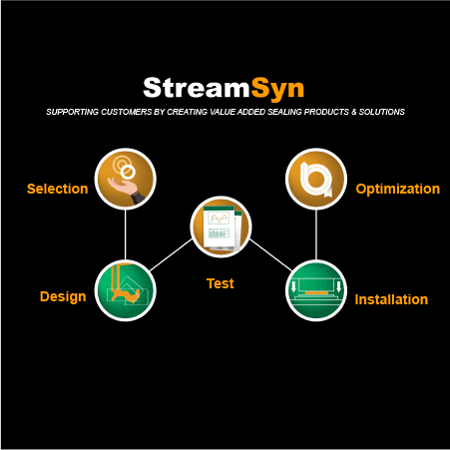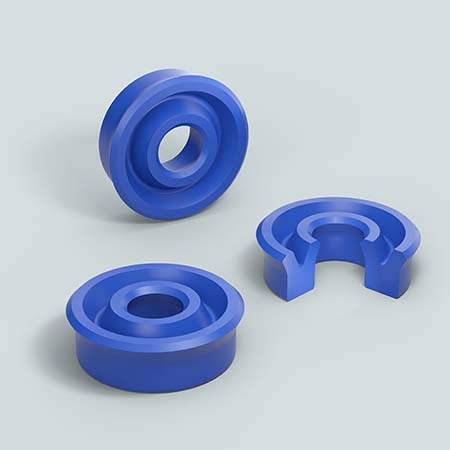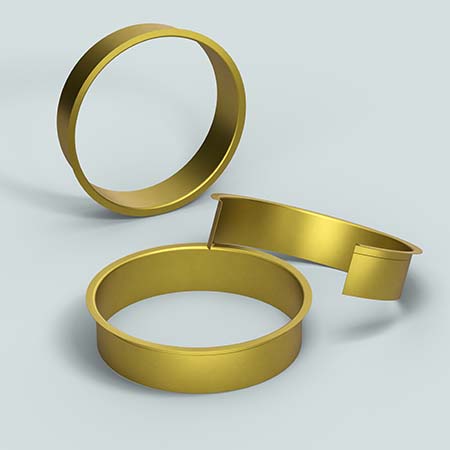NAK is one of the very few companies from around the globe to offer a complete Sealing Solution for almost all applications under one roof. We make oil seals for automotive, industrial, agricultural and construction machinery, as well as many others.
StreamSyn
NAK works with customers, partnering with them, to develop seals that best suit their application. Through clear communication, we take time to understand our customers’ needs at every stage, including seal selection, design, test, seal installation, and seal performance optimization. We work together to help improve the performance and value of the customers’ products.
The following is an outline of the important steps of the StreamSyn Sealing Solutions process:Selection, Design, Test, Installation and Optimization.
Sealing Solution
is NAKs customized, high-performance seal development process. This process gives our customers freedom in design as they are no longer restricted to standard seals. Our Sealing Solution includes hydraulic sealing solutions and wear sleeves that provide a fast, economical solution for shaft repair. NAKs customers can now continuously improve the performance of their products, and through the StreamSyn Sealing Solution process, we can customize seals to meet any requirements. If you are interested in any of our seal products or wish to know more about our design services, please don’t hesitate to contact us. We will try our best to meet your needs.NAK works with customers, partnering with them, to develop seals that best suit their application. Through clear communication, we take time to understand our customers’ needs at every stage, including seal selection, design, test, seal installation, and seal performance optimization. We work together to help improve the performance and value of the customers’ products.
The following is an outline of the important steps of the StreamSyn Sealing Solutions process:Selection, Design, Test, Installation and Optimization.
Sealing Solution
NAK Sealing Technologies Corporation
To find and shop the best Sealing Solution, you need to know about the highest quality of Sealing Solution manufacturer, supplier, wholesaler, distributor, OEM and ODM from a factory in Taiwan
Sealing Solution
none
999999999
http://schema.org/InStock
USD
2020-12-31
https://www.oilsealssupplier.com/custom-seals.html
NAK Sealing Technologies Corporation
90out of
100based on
100user ratings
StreamSyn Sealing Solution is our customized, high-performance seal development process. This process gives our customers freedom in design , because they are no longer restricted by the standard seals available. Our customers can continuously improve the performance of their products, and through the StreamSyn Sealing Solution process, we can customize seals to match any needs.
NAK provides customers with a seal development team, capable of solving problems at every stage of the process, including seal research and development, through to product assembly. This gives our customers more time and freedom to focus on their own product development and innovation.
NAK works with customers, partnering with them, to develop seals that best meet their needs. Through thorough communication, we take time to understand our customers’ needs at every stage, including seal selection, design, test, seal installation, and seal performance optimization. We work together to help improve the performance and value of the customers’ products.
The following is an outline of the important steps of the StreamSyn Sealing Solutions process: Selection, Design, Test, Installation and Optimization.
Selection
NAK provides over 100,000 sets of tooled items, which means that most customers can find the seals they need. However, if they cannot find the right size from the tooled items, or if they have special requirements, we can definitely customize the best seal for them.
In the seal development process, selection is the first and most important step. At this stage the customer needs to submit an Engineering Request Form (ERF). The ERF asks about all of the relevant details for developing the seal, including application, seal location, shaft and bore size, shaft and bore material and surface treatment, temperature, external and internal medium type, speed, pressure, shaft actuation method, bearing type, installation method, and so forth.
We very carefully review all of the information provided by the customers. Combining NAK design standards with the customers’ special requirements, we provide the assistance necessary to assist the customers in choosing the proper seal types and materials.
Design
The next stage in the development process is to focus on the functional design of the seal. Engineers balance efficiency with quality by using Design Of Experiment (DOE) and Finite Element Analysis (FEA) methods to hone in on the optimal design parameters as well as the optimal production conditions for each product.
DOE
DOE is an optimization tool used for product research and development. It uses mathematical models and statistics to configure experiments. This helps to achieve the ideal goals of the experiment with the least number of experiments, in the shortest amount of time. NAK uses experimental design methods to develop new seal structures and rubber formulas. These methods can greatly shorten the development time for new products, optimize product performance and improve product quality.
FEA
FEA is a numerical analysis method that can be integrated with the design software (CAD) which constructs a geometric model of the product. That model is then put into CAE software. Engineers can use CAE to simulate the stress and strain on a seal after being subjected to forces, calculate the forces in dynamic testing and use the data analysis results to verify the design, to produce the very best results.
Engineers use CAE to run simulations to evaluate the samples before proofing, avoid potential design errors, accelerate product development, reduce test costs, improve production yield and quality, and shorten product development cycles.
Engineers apply the material constants established by NAK over years of experience and have successfully used CAE to design seals . They can simulate the suitability of various types of oil seals in the assembly and how they contact and interact with their mechanical counterparts (shafts, bores, and so on)after assembly, evaluate the contact width and stress distribution to understand whether a design is feasible.
Our engineers have complete professional training in sealing technology as well as familiarity with DOE, FEA, CAE, and other tools. Their training covers areas like tribology, fluid mechanics, thermodynamics, material science, manufacturing engineering, and industrial applications. Our qualified engineers are trained to optimize sealing functions according to NAK design standards. Strengthened seals demonstrate a superior sealing performance to standard seals, which allows them to meet the previously unmeetable needs. To give an example: the oil seal design for a precision reducer not only meets the radial force thresholds required for a seal, but also reduces the torque of the oil seal, reduces energy consumption, and accommodates the operating efficiency of the reducer. Compared to traditional standard oil seals, the low-torque oil seals can increase the efficiency of a precision reducer by about 3%-10%.
The following lists some of the more common custom oil seal designs for industrial seals.
A low-torque seal design which greatly improves the operating efficiency of the equipment by 3% - 10%
A seal that with low temperature-rise factor will extend the service life. High temperatures will accelerate the aging of oil seals, bearings, and oil. The specially designed NAK oil seal has an average service life of more than 8 years.
A seal with a helix that’s designed to improve sealing effect. The helix helps the oil to return back into the machine, thus reducing the risk of oil leakage. The type, number, angle, height and width of the helix affect the oil pumping effect.
An anti-rust design that ensures the normal operation of the oil seal. The metal cases are covered in rubber to keep out rust forming agents like water and oxygen. This prevents the iron parts from rusting, deforming, and affecting the seal.
Additional shield lip design that protects the main lip of the seal. The extra shield lip design protects against internal pollutants (such as metal powders caused by gear wear, and fine lubricant particulates formed in the aging process) , and reduces the wear of the main lip.
Food-grade rubber effectively inhibits the breeding and growth of bacteria. The rubber material has passed national certifications for the JIS and FDA.
Test
After the seal is developed, it will be subjected to a series of functional tests and experiments. To ensure the most accurate test data, our software, hardware and equipment in the lab were fully upgraded in 2019. Our engineers have undergone rigorous professional training and they conduct the tests in accordance with international test specifications as well as any special conditions as specified by the customer. The most commonly used industrial seal test range includes the following 9 items.
Torque Test
Function Test
Seal Life Test
Compatibility Test
Pumping Test
Wear Test
High Pressure Test
Mud Slurry Test
Press Fit Test
Installation
It is essential that a seal be installed correctly so as to avoid damaging the seal which may cause the seal to fail or not function properly. NAK provides the very best installation guidance that works with the structural design of the customer’s product, and the assembly process of the production line. NAK also assists the customer in designing the installing tool so that the seal can be protected and installed correctly during the installation process. NAK takes the assembly process into account during seal design phase, and uses years of design experience to improve the efficiency and convenience of the assembly. This lowers the cost of the seal installation.
We provide the following services:
Lip pre-greasing services to improve the assembly efficiency. NAK uses special equipment to apply grease on the seal lips, which can control the exact amount applied and avoid some of the risks associated with a manual application.
Anti-sticking design for the seals so that they are easier to separate one from another. Sometimes the seals can stick to each other when they are stacked together. We employ an electrical discharge process on the face of the seal to increase the surface roughness that prevents sticking.
The corrugated OD design cuts down on labor during installation. The corrugated OD design can reduce the concentration of stress during installation and lower the press fit by about 29%.
Optimization
NAK uses professional failure analysis methods so that if a seal does fail, we can find the root cause, and assist customers in improving and optimizing products for future use. The seal optimization process includes investigation and understanding, root cause analysis, sealing solution, and performance validation.
Investigation and understanding
When inspecting a failed seal provided by a customer, sometimes the cause of a seal failure is not overtly apparent. For this reason, it is necessary to conduct on-site investigations as well as interview users to better understand how the seal failed, the operating environment, the conditions under which it failed, and other important clues as to what happened. Only when we restore the facts can we provide the correct guidance for the subsequent optimization steps. The optimization steps provide guidance for how to improve.
Root Cause Analysis
There are many ways in which a seal can fail, and many of those reasons can not be ascertained through observation alone. Experiments and data analysis are needed to clarify the true causes. NAK engineers search for the key factors in a seal’s failure by analyzing the appearance and dimensions of the seal, lip wear, and shaft wear.
Sealing Solution
Once the real cause of failure is determined, we can target the point of failure with our design optimization. The NAK technical service team has a very rich experience in seal design, and is masterful at understanding the influence of shaft and bore sizes, operating temperatures, installation locations, medium types, pressures, speed, and installation methods on seals. Engineers can use FEA and DOE methods to conduct various experiments, run and analyze simulations, and from there optimize the seal’s design.
Performance Validation
The final step of seal optimization is dynamic verification. The NAK dynamic laboratory has a complete set of functional testing equipment. This equipment can physically simulate the sealing effect of seals in a variety of different test environments.
NAK Sealing Technologies Corporation
To find and shop the best Sealing Solution, you need to know about the highest quality of Sealing Solution manufacturer, supplier, wholesaler, distributor, OEM and ODM from a factory in Taiwan
Hydraulic Sealing Solution
none
999999999
http://schema.org/InStock
USD
2020-12-31
https://www.oilsealssupplier.com/hydraulic-sealing-solutions.html
NAK Sealing Technologies Corporation
90out of
100based on
100user ratings
NAK offers piston seals, rod seals, wiper seals, buffer seals, wear rings etc. for the hydraulic cylinder.
Hydraulic rod seals prevent fluid from leaking out of the gap between the piston rod and cylinder.
Hydraulic piston seals prevent internal leak between piston and cylinder.
Wipers keep dirt, foreign matter, debris, moisture, and contaminants from getting into the hydraulic cylinder when the rod is retracted into the cylinder.
NAK offers a complete range of hydraulic seals for linear and static hydraulic applications. Through thorough communication, we take time to understand our customers’ needs in every area, including seal selection, design, testing, seal installation, and seal performance optimization. We work together with our customers to help improve the performance and value of the customers’ products.
NAK Sealing Technologies Corporation
To find and shop the best Sealing Solution, you need to know about the highest quality of Sealing Solution manufacturer, supplier, wholesaler, distributor, OEM and ODM from a factory in Taiwan
Wear-Pro Sleeve
none
999999999
http://schema.org/InStock
USD
2020-12-31
https://www.oilsealssupplier.com/wear-sleeve.html
NAK Sealing Technologies Corporation
90out of
100based on
100user ratings
The wear sleeve is a thin stainless steel metal sleeve with specially treated surface, designed to provide a counterface surface for radial shaft seals. With the wear sleeve, the same sized seal can be used and no shaft disassembly and machining is needed. To make the installation process fast, simple and convenient, the sleeve set is packaged separately and includes both the Wear-Pro Shaft Protection Sleeve as well as the installation fixture. This also makes subsequent maintenance and replacement easier.
 English
English Français
Français Deutsch
Deutsch Русский
Русский Português
Português Italiano
Italiano हिन्दी
हिन्दी Español
Español Nederlands
Nederlands العربية
العربية Tiếng Việt
Tiếng Việt ไทย
ไทย Indonesia
Indonesia 日本語
日本語 Türkçe
Türkçe 简体中文
简体中文

